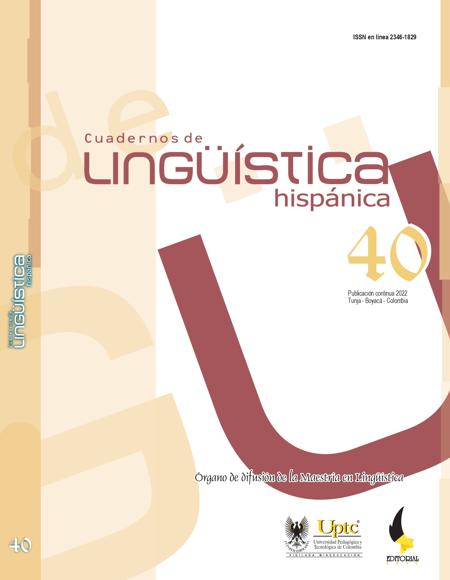Modélisation des erreurs d’accord pluriel en espagnol LE par le biais de systèmes dynamiques

Résumé
Les erreurs d’accord nominatifs pluriels sont modélisées pour un corpus d’espagnol langue étrangère de quatre apprenants : SONIA (niveau A1/A2), NATI (niveau B1), JAKO (niveau B2), MIRKA (niveau C1). Dans le cadre des systèmes dynamiques, il est postulé que les concordances “correctes” et “incorrectes” constituent des attractrices discrètes stables vers lesquelles converge le flux continu du système dans trois modèles de simulation simples : Lokta-Volterra, jeu de coordination (théorie des jeux évolutifs), montée en gradient. En général, les modèles se rapprochent mieux au modèle d’erreur global qu’à celui de sessions. Dans ce dernier, le modèle basé sur Lokta-Volterra offre de meilleures performances pour SONIA, NATI et JAKO. MIRKA obtiennent les plus mauvaises performances dans tous les modèles mais leur erreur diminue avec le modèle de montée en gradient. Les schémas d’apprentissage s’auto-organisent et émergent de la dynamique de micro-systèmes d’accord.
Mots-clés
modelo de simulación, adquisición de L2, sistemas dinámicos, número plural
Biographie de l'auteur
Pablo Ezequiel Marafioti
Doctor en Ciencias del Lenguaje por la Universidad Nacional de Córdoba, Argentina; especialista en Lingüística Teórica y Aplicada por la Universidad de Pavía, Italia; licenciado en Letras (orientación en Lingüística) por la Universidad de Buenos Aires, Argentina. Realizó varios posgrados en Estadística. Áreas de especialización: sistemas dinámicos, modelos estadísticos y de minería de datos aplicados al cambio lingüístico y a la adquisiciónde lenguas extranjeras
Références
- Brehm, L, Cho, P. W., Smolensky, P. y Goldrick, M. (2022). PIPS: a parallel planning model of sentence production. Cognitive Science, 46. https://doi.org/10.1111/cogs.13079
- Cho, P. W., Goldrick, M., y Smolensky, P. (2017). Incremental parsing in a continuous dynamical system: Sentence procesing in Gradient Symbolic Computation. Linguistics Vanguard, 3(1). https://doi.org/1.1515/lingvan-2016-0105
- Cho, P. W., Goldrick, M., Lewis, R., y Smolensky, P. (2018). Dynamic encoding of structural uncertainty in gradient symbols. En A. Sayeed, C. Jacobs, T. Linzen y M. van Schijndel (Eds.), Proceedings of the 8th Workshop on Cognitive Modeling and Computational Linguistics (pp. 19-28). Salt Lake City, Utah, USA. https://doi.org/1.18653/v1/W18-01
- Cho, P. W., Goldrick, M., y Smolensky, P. (2020). Parallel parsing in a Gradient Symbolic Computation parser [en línea]. https://doi.org/1.31234/osf.io/utcgv
- Davis, C., y Perea, M. (2005). BuscaPalabras: a program for deriving orthographic and phonological neighborhood statistics and other psycholinguistic indices in Spanish. Behavior Research Methods, 37(4), 665-671. https://doi.org/1.3758/BF03192738.
- Deo, A. (2015). The semantic and pragmatic underpinnings of grammaticalization paths: The progressive to imperfective shift. Semantics and Pragmatics, 8, 1-52. http://dx.doi.org/1.3765/sp.8.14
- Kaplan, D., y Glass, L. (1995). Understanding Nonlinear Dynamics. New York: Springer.
- Kilgarriff, A., Baisa, V., Bušta, J., Jakubíček, M., Kovář, V., Michelfeit, J., Rychlý, P., y Suchomel, V. (2014). The Sketch Engine: Ten years on. Lexicography, 1(1), 7-36. https://doi.org/1.1007/s40607-014-0009-9.
- Kot, Mark (2001). Elements of mathematical ecology. Cambridge University Press.
- Nerbonne, J., Van Ommen, S., Gooskens, C., y Wieling, M. (2013). Measuring socially motivated pronunciation differences. En L. Borin y A. Saxena (Eds.), Approaches to Measuring Linguistic Differences (pp. 107–140). https://doi.org/1.1515/9783110305258.
- MacWhinney, B. (2015). Introduction. En B. MacWhinney y W. O’Grady (Eds.), The Handbook of Language Emergence (pp. 1-31). Sussex: Wiley y Sons.
- Mac Whinney, B. (2021). The Childes Project: Tools for Analyzing Talk. Part 1 y 2 [en línea]. Disponible en: https://talkbank.org/manuals/CHAT.pdf.
- Marafioti, P. E. (2021). Factores influyentes en tipos de errores de concordancia nominal en un corpus de cuatro aprendientes italianos de español LE. Lenguaje, 49(2), 365-393. https://doi.org/10.25100/lenguaje.v49i2.10915.
- Marafioti, P. E. (2022). Análisis de tiempos hasta que se produce un error de concordancia en cuatro estudiantes italianos de ELE. Revista argentina de ciencias del comportamiento, 13(2). [en prensa]
- Murray, James D. (2002). Mathematical Biology I. An Introduction (3ra. ed.). New York: Springer.
- Peña, D. (2002). Análisis de Datos Multivariantes. Mc Graw Hill.
- R Development Core Team. (2021). R: a language and environment for statistical computing. R Foundation for Statistical Computing, Vienna, Austria. http://www.R-project.org.
- Smith, G., y Tavor, W. (2018). Toward a Theory of Timing Effects in Self-Organized Sentence Processing. En I. Juvina, J. Houpt y C. Myers (Eds.), Proceedings of the 16th international conference on cognitive modeling (pp. 138-143). Madison, Wisconsin: University of Wisconsin. http://acs.ist.psu.edu/papers/ICCM%202018%20Proceedings.pdf
- Smith, G., Franck, J., y Tabor, W. (2018). A self-organizing approach to subject-verb number agreement. Cognitive Science, 42(S4), 1043–1074. https://doi.org/1.1111/cogs.12591.
- Smith, G., Franck, J., y Tabor, W. (2021). Encoding interference effects support self-organized sentence processing. Cognitive Psychology, 124(101356). https://doi.org/1.1016/j.cogpsych.202.101356
- Smolensky, P, Goldrick, M., y Mathis, D. (2014). Optimization and quantization in gradient symbol systems: a framework for integrating the continuous and the discrete in cognition. Cognitive Science, 38(6), 1102-1138. https://doi.org/1.1111/cogs.12047
- Scrucca, L., Fop, M., Murphy, T, y Raftery, A. (2016). Mclust 5: Clustering, classification and density estimation using Gaussian finite mixture models. The R Journal, 8(1), 289-317. https://doi.org/1.32614/RJ-2016-021.
- Van Buuren, S., y Groothuis-Oudshoorn, K. (2011). Mice: multivariate imputation by chained equations in R. Journal of Statistical Software, 45(3), 1-67. https//doi.org/10.18637/jss.v045.i03
- Weibull, J. W. (1997). Evolutionary game theory. Massachusetts: MIT Press.
